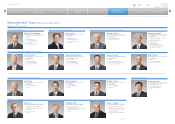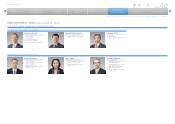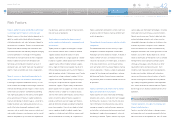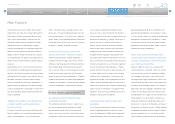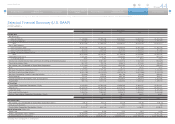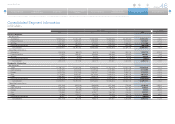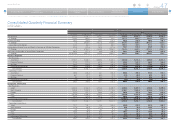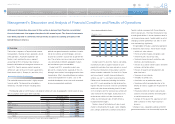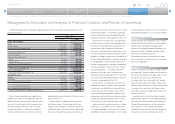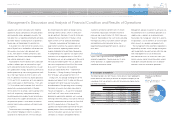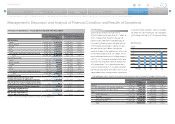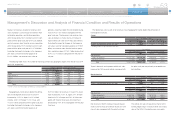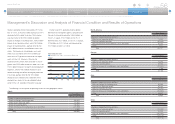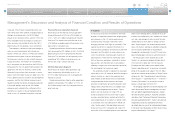Toyota 2014 Annual Report Download - page 49
Download and view the complete annual report
Please find page 49 of the 2014 Toyota annual report below. You can navigate through the pages in the report by either clicking on the pages listed below, or by using the keyword search tool below to find specific information within the annual report.
ANNUAL REPORT 2014
President’s MessagePresident’s Message
Overview of
Four Business Units
Overview of
Four Business Units
Special FeatureSpecial Feature
Review of OperationsReview of Operations
Consolidated Performance
Highlights
Consolidated Performance
Highlights
Management and
Corporate Information
Management and
Corporate Information
Investor InformationInvestor Information
Financial SectionFinancial Section
Page 49
NextPrev
ContentsSearchPrint
profitability of Toyota’s automotive operations.
These laws, regulations and policies include those
attributed to environmental matters, vehicle safety,
fuel economy and emissions that can add signifi-
cantly to the cost of vehicles. The European Union
has enforced a directive on end-of-life vehicles. See
“Legislation Regarding End-of-Life Vehicles”,
“Information on the Company — Business Overview
— Governmental Regulation, Environmental and
Safety Standards” and note 23 to the consolidated
financial statements in Toyota’s annual report on
Form 20-F for a more detailed discussion of these
laws, regulations and policies.
Many governments also impose local content
requirements, impose tariffs and other trade barri-
ers, and enact price or exchange controls that can
limit an automaker’s operations and can make the
repatriation of profits unpredictable. Changes in
these laws, regulations, policies and other govern-
mental actions may affect the production, licensing,
distribution or sale of Toyota’s products, cost of
products or applicable tax rates. From time-to-time
when potential safety problems arise, Toyota issues
vehicle recalls and takes other safety measures
including safety campaigns relating to its vehicles. In
November 2009, Toyota announced a safety cam-
paign in North America for certain models of Toyota
and Lexus vehicles related to floor mat entrapment
of accelerator pedals, and later expanded it to
include additional models. In January 2010, Toyota
announced a recall in North America for certain
models of Toyota vehicles related to sticking and
and dealers. Toyota believes that its ability to pro-
vide financing to its customers is an important value
added service. Therefore, Toyota has expanded its
network of finance subsidiaries in order to offer
financial services in many countries.
Toyota’s competitors for retail financing and retail
leasing include commercial banks, credit unions
and other finance companies. Meanwhile, commer-
cial banks and other captive automobile finance
companies also compete against Toyota’s whole-
sale financing activities.
Toyota’s total finance receivables increased dur-
ing fiscal 2014 mainly due to the favorable impact of
fluctuations in foreign currency translation rates and
an increase in retail receivables.
slow-to-return accelerator pedals. Also in January
2010, Toyota recalled in Europe, China and other
regions certain models of Toyota vehicles related to
sticking accelerator pedals. In February 2010,
Toyota announced a worldwide recall related to the
software program that controls the antilock braking
system in certain vehicle models including the Prius.
The recalls and other safety measures described
above have led to a number of claims and lawsuits
against Toyota. For a more detailed description of
these claims and lawsuits, see “Information on the
Company — Business Overview — Legal Proceedings”
and note 23 to the consolidated financial state-
ments in Toyota’s annual report on Form 20-F.
The worldwide automotive industry is in a period
of global competition which may continue for the
foreseeable future, and in general the competitive
environment in which Toyota operates is likely to
intensify. Toyota believes it has the resources, strat-
egies and technologies in place to compete effec-
tively in the industry as an independent company for
the foreseeable future.
Financial Services Operations
The competition in the worldwide automobile finan-
cial services industry is intensifying. As competition
increases, margins on financing transactions may
decrease and market share may also decline as
customers obtain financing for Toyota vehicles from
alternative sources.
Toyota’s financial services operations mainly
include loans and leasing programs for customers
Management’s Discussion and Analysis of Financial Condition and Results of Operations
20,000
0
15,000
10,000
5,000
FY
Total Assets by Financial Services Operations
(¥ Billion)
’10 ’11 ’12 ’13 ’14
Selected Financial Summary (U.S. GAAP) Consolidated Segment Information Consolidated Quarterly Financial Summary Management’s Discussion and Analysis of Financial Condition and Results of Operations [2 of 14] Consolidated Financial Statements


